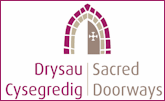St Michael’s Church, Caerwys
This church is dedicated to St Michael the Archangel. The cult of St Michael became very popular in Wales in the 8th century, and it’s likely the original church on this site was founded at that time.
 The earliest written reference to the church is in 1244, when the Pope chose St Michael’s as the venue for a court hearing to decide whether Prince Dafydd ap Llywelyn, son of Llywelyn the Great, had been forced to agree a treaty with King Henry III.
The earliest written reference to the church is in 1244, when the Pope chose St Michael’s as the venue for a court hearing to decide whether Prince Dafydd ap Llywelyn, son of Llywelyn the Great, had been forced to agree a treaty with King Henry III.
The next mention of St Michael’s is in 1284, when the sum of 60 shillings was paid to Jervasius, the rector, as compensation for the loss of tithe payments and damage done to the church by King Edward I’s soldiers during his conquest of Wales.
Some parts of the existing church date from the 13th century, including the tower and the nave. Inside the church there’s a 13th-century effigy that supposedly depicts Elizabeth Ferrers, wife of Dafydd ap Gruffydd, who was Prince of Wales in 1282 and 1283.

There are also a number of 14th-century sepulchral slabs with cross-heads, and stained glass windows dating from the 15th century. The 19th-century ‘Eisteddfod Window’ celebrates the Eisteddfod declared in Caerwys in 1523 and held in 1524. This was a meeting of bards to formalise rules for Welsh poetry.
Memorials include a tablet commemorating the Rev John Lloyd, who accompanied writer and naturalist Thomas Pennant on his ‘Tours of Wales’. An inscribed tombstone built into the south wall’s exterior is said to mark the tomb of Robert Evans, known as ‘The Boy Rector’. He died in 1582, aged 19.
Both of the images shown here are courtesy of Llyfrgell Genedlaethol Cymru – the National Library of Wales. The photo was taken by John Thomas c.1875 and shows the church shortly before a restoration project which included removing the large buttresses.
The portrait of Rev Richard Richards, rector of Caerwys, is a copy of an original presented to him in a ceremony at the church in 1848 – along with a silver tea and coffee service and other gifts – in thanksgiving for his Church work at home and abroad. He was a celebrated missionary whose preaching style, in English and Welsh, was described as “pictorial”.
With thanks to Suryiah Evans and the National Library of Wales
Postcode: CH7 5BW View Location Map
More information about the church from Clwyd-Powys Archaeological Trust


